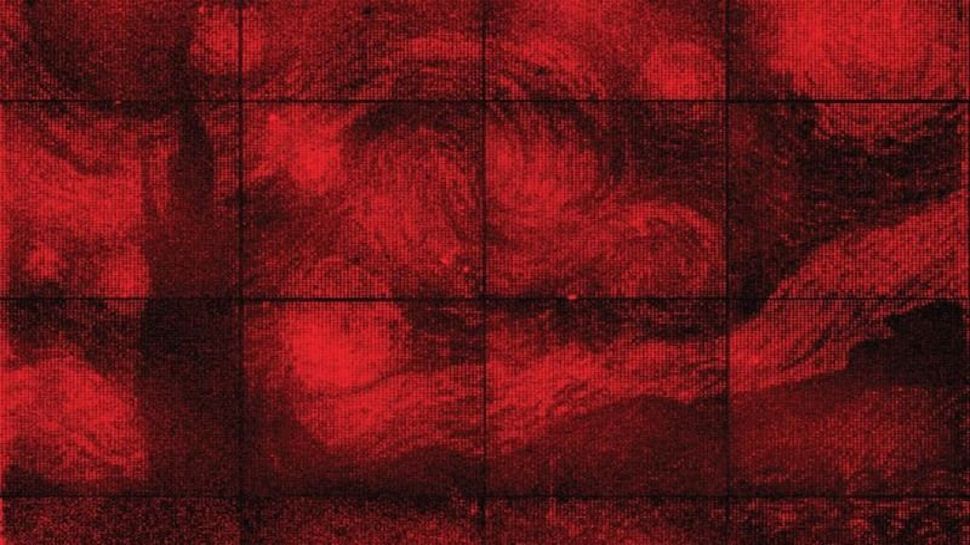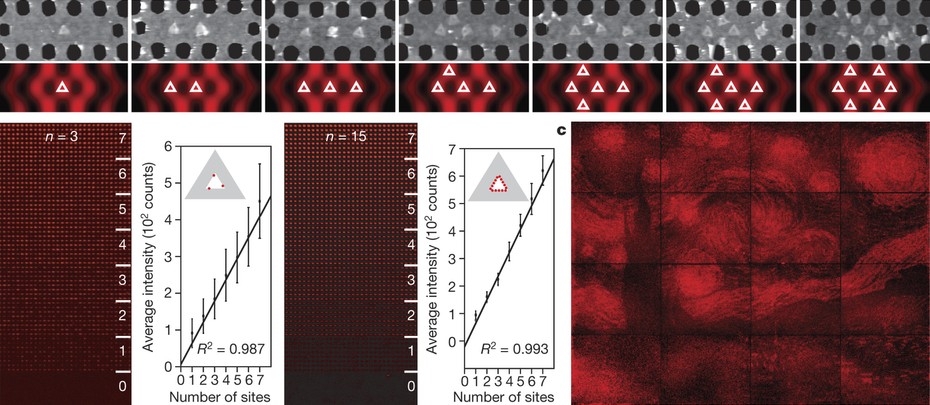Van Gogh's "Starry Night" made of DNA origami became reality
A curious way to use DNA capabilities at the level of a promising technology was suggested by researchers from the California Institute of Technology, who created with its help a reproduction of Vincent Van Gogh's famous Starry Night painting. What you see below on a monochromatic image the size of a ten-kopeck coin is the result of the folding of the DNA molecules, accompanied by the reorientation of the luminous molecules in strictly defined places - the “cells” of the microscopic optical resonators. The proposed technology for controlling the DNA folding process, in the opinion of its authors, will in the future allow the creation of fully functional nanoscale biocomputers.

DNA origami technology, which allows the long DNA molecule to communicate any predetermined shape and properties, was developed by Paul Rothemund from the California Institute of Technology about 10 years ago. Then the scientist managed to create from the DNA molecule of bacteriophage M13 several elementary geometric forms - triangles, stars, rectangles and smiles.
In brief, we recall that the origami DNA technique is based on the principle of complementarity, which describes the structure of double-stranded DNA. Such biomolecules are long filaments on which four types of beads, nitrogenous bases are located — guanine, adenine, cytosine, and thymine. In the double helix opposite adenine, only thymine can be located, and opposite to guanine, only cytosine, etc.
')
Having information about the location of the bases in a single-stranded DNA molecule, it is possible to choose for it sets of short “clips” that force the chain to compactly fold into the desired shape, for example, into a flat sheet. As Paul Rotmund notes, the development and synthesis of such “clips” takes about two weeks, and the process of creating origami takes about several hours after the components are mixed in solution.
DNA formed according to the desired “scenario” can act as a platform into which you can integrate all sorts of nanometer-scale components, from molecules of a fluorescent substance and carbon nanotubes to mini-capsules with drugs and elements of microscopic biocomputers. However, to achieve the goals and create the most promising workable nanodevices, the presence of a single DNA-based base is not enough.
In 2009, Paul Rotmund and a group of specialists from IBM Research, using the electron-beam lithography method, first described and later implemented the technology of ultra-precise placement of DNA molecules in a given order. All subsequent years until now, Rotmund and colleagues from the California Institute of Technology under the leadership of Ashwin Gopinath (Ashwin Gopinath) - Professor at the Department of Bioengineering of the California Institute of Technology have improved the development and, as a result, were able to offer a way to accurately position the DNA molecules on the surfaces of almost any complex shape, including the surface of the semiconductor chip. An example of what effect can be achieved using the proposed technology was the miniature reproduction of Van Gogh's Starry Night, created by scientists. Rotmund and his colleagues used DNA origami techniques for directionally attaching phosphor molecules to the surface of a two-dimensional photonic crystal. By itself, a crystal is an ordered structure resembling a honeycomb. And for its manufacture, scientists used the method of etching the surface with an electron beam.
“What we have created in a simplified way can be compared to screwing molecular“ light bulbs ”into microscopic cartridges with the help of DNA origami,” explains Paul Rotmund, “At the same time, by controlling the relative position of the molecules and the distance between them and the light sources, we could to be able to change the brightness of each such "light bulb" in the desired range. The reproduction we created is nothing more than a matrix of 65,536 pixels, 256 by 256 in size, with different luminosities. ” Moving origami DNA in a matrix with a pitch of 20 nm, the researchers were able to get a drawing resembling chessboard cells with areas of different levels of luminous intensity of molecular “light bulbs” in “cold” and “hot” points.

The principle of assembling DNA origami and creating a photonic crystal (upper and middle row). Bottom row: origami attachment method to a photonic crystal (due to carboxyl groups), origami micrographs on the crystal surface. The lower right corner is the reflection spectrum of the region to which the molecule with the phosphor is attached. Ashwin Gopinath et al. / Nature, 2016

The dependence of the brightness of the phosphor on the origami position inside the "substrate". Ashwin Gopinath et al. / Nature, 2016
“All previous work related to the creation of nanoscale emitters of light allowed to place only a few working“ lamps ”due to the extreme difficulty of reproducing the control circuit of the device, largely dependent on the number and position of the emitters in the cavity,” Gopinath notes. The new technology allows you to set from zero to seven origami DNA, which makes it possible to digitally control the brightness of each lamp without restrictions.

The location of the origami adapters in the cavities. Test experiments on the transfer of color and "Starry Night". Ashwin Gopinath et al. / Nature, 2016
The problem is, the scientist explained, that fluorescent molecules after their redistribution on the substrate "live" for about 45 seconds. After that, they react with oxygen and burn. In this process, they begin to emit light of several shades of red, but not of one pure color. The results obtained inspired researchers to search for a solution to this problem, the elimination of which, in their opinion, will make it possible to implement the latest promising technologies, up to the technologies used in nanoscale quantum computing systems.
A source
Nature
That's all with you was Dronk.Ru. Do not forget to return money for purchases in China and subscribe to our blog , there will be many more interesting things.
We recommend:
- Save up to 8% on every purchase on AliExpress and other online stores in China
- Why do online stores give money for purchases?
- Return your money - Choose a cashback service for Aliexpress
- The history of the development of Dronk.ru - from choosing quadcopters to returning money for purchases on AliExpress and not only
- The best cashback service or 5 main criteria for evaluating cashback service

DNA origami technology, which allows the long DNA molecule to communicate any predetermined shape and properties, was developed by Paul Rothemund from the California Institute of Technology about 10 years ago. Then the scientist managed to create from the DNA molecule of bacteriophage M13 several elementary geometric forms - triangles, stars, rectangles and smiles.
In brief, we recall that the origami DNA technique is based on the principle of complementarity, which describes the structure of double-stranded DNA. Such biomolecules are long filaments on which four types of beads, nitrogenous bases are located — guanine, adenine, cytosine, and thymine. In the double helix opposite adenine, only thymine can be located, and opposite to guanine, only cytosine, etc.
')
Having information about the location of the bases in a single-stranded DNA molecule, it is possible to choose for it sets of short “clips” that force the chain to compactly fold into the desired shape, for example, into a flat sheet. As Paul Rotmund notes, the development and synthesis of such “clips” takes about two weeks, and the process of creating origami takes about several hours after the components are mixed in solution.
DNA formed according to the desired “scenario” can act as a platform into which you can integrate all sorts of nanometer-scale components, from molecules of a fluorescent substance and carbon nanotubes to mini-capsules with drugs and elements of microscopic biocomputers. However, to achieve the goals and create the most promising workable nanodevices, the presence of a single DNA-based base is not enough.
In 2009, Paul Rotmund and a group of specialists from IBM Research, using the electron-beam lithography method, first described and later implemented the technology of ultra-precise placement of DNA molecules in a given order. All subsequent years until now, Rotmund and colleagues from the California Institute of Technology under the leadership of Ashwin Gopinath (Ashwin Gopinath) - Professor at the Department of Bioengineering of the California Institute of Technology have improved the development and, as a result, were able to offer a way to accurately position the DNA molecules on the surfaces of almost any complex shape, including the surface of the semiconductor chip. An example of what effect can be achieved using the proposed technology was the miniature reproduction of Van Gogh's Starry Night, created by scientists. Rotmund and his colleagues used DNA origami techniques for directionally attaching phosphor molecules to the surface of a two-dimensional photonic crystal. By itself, a crystal is an ordered structure resembling a honeycomb. And for its manufacture, scientists used the method of etching the surface with an electron beam.
“What we have created in a simplified way can be compared to screwing molecular“ light bulbs ”into microscopic cartridges with the help of DNA origami,” explains Paul Rotmund, “At the same time, by controlling the relative position of the molecules and the distance between them and the light sources, we could to be able to change the brightness of each such "light bulb" in the desired range. The reproduction we created is nothing more than a matrix of 65,536 pixels, 256 by 256 in size, with different luminosities. ” Moving origami DNA in a matrix with a pitch of 20 nm, the researchers were able to get a drawing resembling chessboard cells with areas of different levels of luminous intensity of molecular “light bulbs” in “cold” and “hot” points.

The principle of assembling DNA origami and creating a photonic crystal (upper and middle row). Bottom row: origami attachment method to a photonic crystal (due to carboxyl groups), origami micrographs on the crystal surface. The lower right corner is the reflection spectrum of the region to which the molecule with the phosphor is attached. Ashwin Gopinath et al. / Nature, 2016

The dependence of the brightness of the phosphor on the origami position inside the "substrate". Ashwin Gopinath et al. / Nature, 2016
“All previous work related to the creation of nanoscale emitters of light allowed to place only a few working“ lamps ”due to the extreme difficulty of reproducing the control circuit of the device, largely dependent on the number and position of the emitters in the cavity,” Gopinath notes. The new technology allows you to set from zero to seven origami DNA, which makes it possible to digitally control the brightness of each lamp without restrictions.

The location of the origami adapters in the cavities. Test experiments on the transfer of color and "Starry Night". Ashwin Gopinath et al. / Nature, 2016
The problem is, the scientist explained, that fluorescent molecules after their redistribution on the substrate "live" for about 45 seconds. After that, they react with oxygen and burn. In this process, they begin to emit light of several shades of red, but not of one pure color. The results obtained inspired researchers to search for a solution to this problem, the elimination of which, in their opinion, will make it possible to implement the latest promising technologies, up to the technologies used in nanoscale quantum computing systems.
A source
Nature
That's all with you was Dronk.Ru. Do not forget to return money for purchases in China and subscribe to our blog , there will be many more interesting things.
We recommend:
- Save up to 8% on every purchase on AliExpress and other online stores in China
- Why do online stores give money for purchases?
- Return your money - Choose a cashback service for Aliexpress
- The history of the development of Dronk.ru - from choosing quadcopters to returning money for purchases on AliExpress and not only
- The best cashback service or 5 main criteria for evaluating cashback service
Source: https://habr.com/ru/post/396227/
All Articles